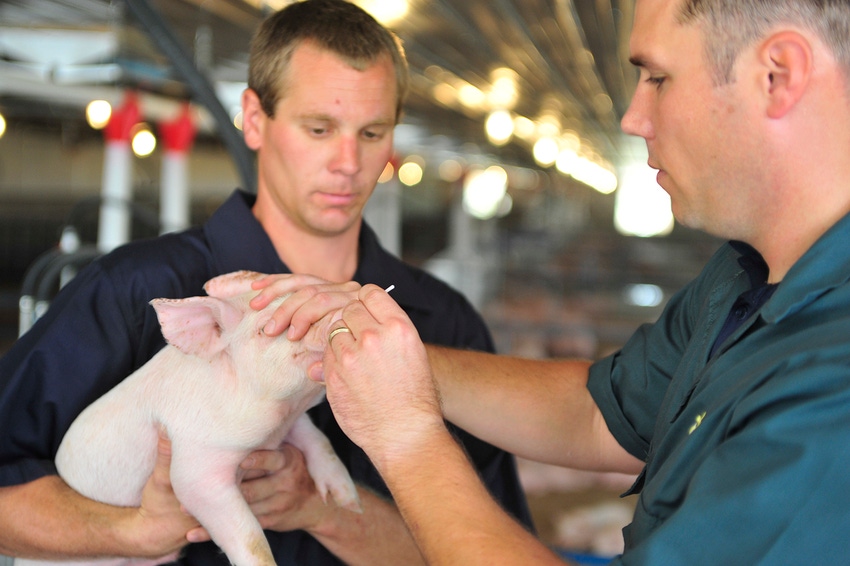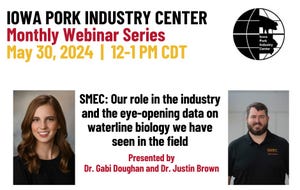Should we be concerned about sample handling for PRRSV detection?
Between time of collection on farm to laboratory testing, samples may have been subjected to adverse handling conditions that could affect PCR results.
February 6, 2024

By Berenice Munguía-Ramírez, Betsy Armenta-Leyva, Jianqiang Zhang, Gaurav Rawal, Luis Giménez-Lirola, Jeffrey J. Zimmerman and Fangshu Ye, Iowa State University; Alexandra Henao-Díaz, PIC Latinoamérica, México; and Ting-Yu Cheng, The Ohio State University
Strategies for porcine reproductive and respiratory syndrome virus prevention and control invariably include diagnostic testing to establish the infection status of the pigs. PCR testing for the detection of PRRSV on different specimens (oral fluid, processing fluid, serum, blood swabs, semen, etc.) is performed on a routine basis by veterinary diagnostic laboratories. For example, in 2023, six midwestern veterinary diagnostic laboratories (Iowa State University, University of Minnesota, Kansas State, South Dakota State ADRDL, Ohio ADDL, and Purdue ADDL) received a total of ~83,000 submissions for PRRSV PCR testing (Swine Disease Reporting System, 2024).
The PCR results are the basis of important in-farm decisions and reflect the quality and quantity of the viral genetic material in the sample at the moment it is processed in the laboratory. However, between the time of collection in the farm, packing, shipping and testing in the laboratory, the sample may have been subjected to adverse handling conditions that could affect PCR results: false negatives are the real concern. While sample quality is a key issue in diagnostic PCR testing, it is not always possible to meet these recommendations on the farm, and samples may have been exposed to less-than-ideal conditions.
In this study, we characterized the effect of temperature × time (Study 1) and freeze-thaw cycles (Study 2) on the detection of PRRSV RNA in serum and oral fluids by RT-qPCR.
Methods
Study 1 (temperature × time): PRRSV-positive serum (n = 5) and oral fluid (n = 5) samples were divided into individual aliquots (n = 28 per specimen) and assigned to one of 28 combinations of storage temperature (4°, 10°, 20° or 30°C) × time (24, 48, 72, 96, 120, 144 or 168 hour). Study 2 (freeze-thaw): PRRSV-positive serum (n = 5) and oral fluid (n = 5) samples were divided into aliquots (n = four per specimen) and assigned to one of four freeze-thaw treatments (2, 5, 10 or 15 cycles).
After completing all treatments on each study, samples were tested for PRRSV RNA by RT-qPCR (IDEXX Laboratories, Inc.). PCR results were re-expressed as “efficiency standardized Cqs (ECqs).” The effect of temperature × time and freeze-thaw cycles on PRRSV RNA was analyzed by a mixed-effects regression model (MRM) (R v4.2.1, R core team, 2022) and expressed as the percentage (%) of PRRSV RNA retained as a function of temperature × time and freeze-thaw cycles.
Results
Study 1: In serum, no significant loss of PRRSV RNA was observed at 4°, 10°C or 20°C for up to 168 hr, i.e., detectable PRRSV RNA was 100% retained. However, storage at 30°C resulted in a 94.7% recovery of PRRSV RNA every 24 hr, with only 63.1% recovery at 168 hr (Figure 1).
In oral fluid, a significant loss of PRRSV RNA (p < 0.05) was observed at all temperature × treatments. The recovery of PRRSV RNA every 24 hr was 93.7%, 90.6%, 86.4%, and 83.4% at 4°, 10°, 20° and 30°C, respectively. At 168 hr of storage, the recovery of detectable PRRSV RNA was 55.7%, 34.0%, 4.6% and 0.0% at 4°, 10°, 20° and 30°C, respectively (Figure 1).
ISU. Figure 1. Percentage (%) of detectable PRRSV RNA retained as a function of storage temperature × time in serum and oral fluid samples tested by RT-qPCR.
Study 2: In serum, no significant freeze-thaw effect was observed on PRRSV RNA for up to 15 freeze-thaw cycles (p > 0.05), i.e., ≥99% recovery of detectable PRRSV RNA by RT-qPCR (Table 1). In oral fluids, a 94.6% recovery of detectable PRRSV RNA was observed at two freeze-thaw cycles, and a 59.8% recovery was observed at 15 freeze-thaw cycles (Table 1).
ISU. Table 1. Percentage (%) of PRRSV RNA retained a function of freeze-thaw cycles in serum and oral fluid samples tested by RT-qPCR.
Conclusions
Overall, the effect of storage temperature and freeze-thaw cycles on PRRSV RNA was specimen-dependent. Based on this data:
Store serum samples at ≤ 20°C to optimize PRRSV RNA detection.
Store oral fluid samples frozen in a non–self-defrosting freezer to prevent loss of detectable PRRSV RNA.
Freeze-thaw cycles in oral fluids should be avoided or minimized before RT-qPCR testing.
Full research article available here.
You May Also Like



